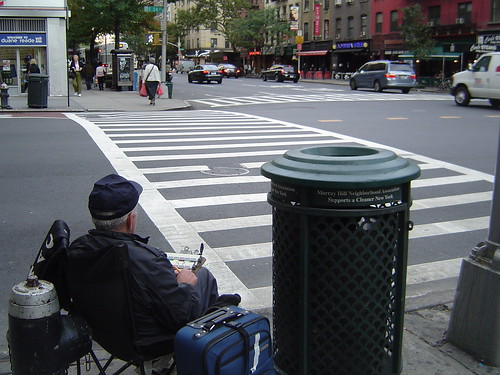State of Urban Informatics Research Intersections
Posted: October 31st, 2008 | 1 Comment »A few thoughts on the state of research in urban informatics sketched from here and there…
With a few workshops (e.g. Digital Cities, UrbanSense, Real-time Cities), loosly-related conferences (e.g. CUPUM, ), books (e.g. Handbook of Research on Urban Informatics, journal special issues (e.g. IEEE Computer, IEEE Pervasive Computing), dispersed research groups (Darthmouth College Sensor Networks Group, MIT SENSEable City Lab and Smart Cities, CMU Living Environments Lab, UCL’s VR Centre for the Built Environment and CASA) extensive blog post (e.g. Julian Bleecker, Karen Martin, Nicolas Nova; Anne Galloway’s blog a research tool) and courses taught at a graduate level (MIT’s ambient informatics, NYU’s urban informatics), urban informatics is not a research field but rather a set of intersecting practices and broader disciplines swirling about those practices. It is still ill-defined and at its infency with a lack of paradigm. I have always presented this intersection with three main tendencies: understanding urban dynamics, understanding the integration of ubiquitous technologies in urban life and designing technologies for people in the city. Others defined it as “the integration of computing, sensing, and actuation technologies in everyday urban settings and lifestyles“ (Kindberg et al., 2007) or “the collection, classification, storage, retrieval, and dissemination of recorded knowledge of, relating to, characteristic of, or constituting a city” (Foth, 2008). To my view, it involves the research on 4 layers:
1. Urban data gathering (What can be sensed?)
2. Urban data analysis (What can we do with what is quantitativly sensed and qualitativly observed?)
3. Information visualization (What can we communicate?)
4. Designing technologies and services for the city (How to design to improve?)

A urban informatics blue collar counting traffic of trucks, cars and bicycle at a random crossroad in a random gridiron plan city.
A majority of research done one or many of these layers has been driven by an utilitarist perspective that models a city as a system and that aims at improving its efficiency. The background of work in that domain partially explain the lack of consideration of human and social realities. Not to blame the, but computer and information scientists, engineers, architects, and urban designers are no necessearly trained in assessing the implications of their interventions. Only recently the technodeterministic approach has been challenged (e.g. in Urban Computing and its Discontents) through the influence of designers (e.g. Adam Greenfield and Dan Hill), social scientists (Anne Galloway, Bruno Latour), historian (e.g. Antoine Picon) and geographers (e.g. Phil Hubbard, Mike Crang and Stephen Graham). Their influence generates the emergence of a new language that computer scientists integrate in their work forging transdisciplinarity skills (highlighted my report of the Real-time City Round Table). In consequence, it is noticeable that now social considerations go beyond privacy issues and touch the domains of the impact of the research (e.g. positive change of practices) and the design for its appropriation (how to integrated into citizen daily life or a city administrative decision process). Nevertheless, research in urban informatics is still at an exploring phase that builds “telescopes” and “microscopes” that paint the city. It will need converging teams and languages to build a field and a science to study “what we see” and help generate theories and a body of knowledge.
Relation to my thesis: forming some thoughts on the context of my research that I can extend in my dissertation.


Nice condensation of the state of the field, Fabien. There are, I think, obvious analogies to the development of HCI (or whatever it is currently morphing into) as a field, coming from human factors and then giving more and more emphasis to the social context. I am of course biased, coming from Denmark, but the trend you describe is all what the Scandinavian tradition of contextualizing ICT is about. The efforts of forming new relations and vocabularies around urban informatics are equally challenging (and exciting, actually). I find that one of the hardest parts of this exercise is to form and sustain strong environments, incorporating academia, industry, business etc., valuing both construction and theorizing, long and short term. As it stands today, the traditional, tech-focused, utilitarian wording is usually still what gets you a grant/internal corporate funding. We have to resist that. E.g., today I found myself joining the Danish Association of Media Researchers. Totally natural to me, but not so from a traditional perspective. I welcome your efforts to formulate this movement.
-Martin